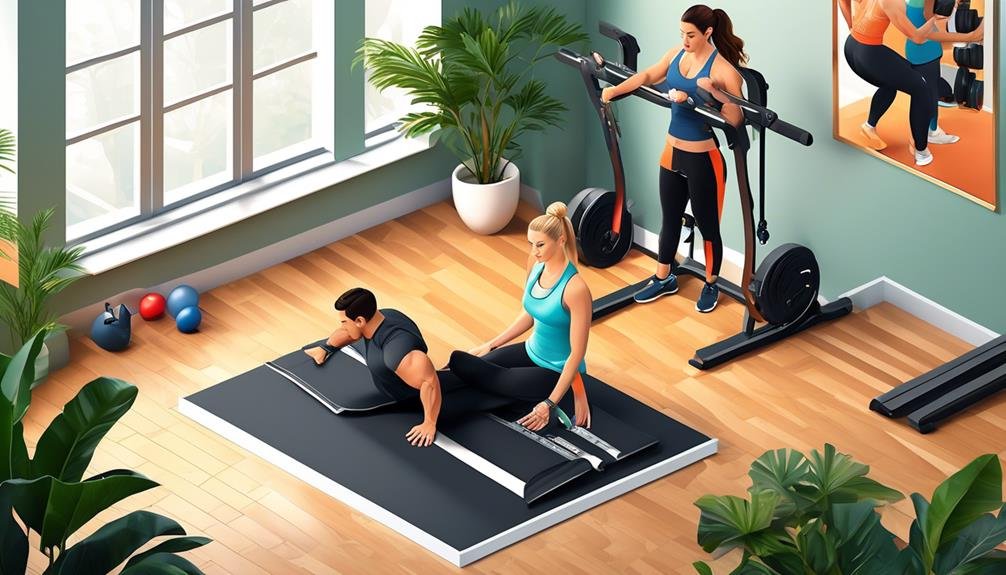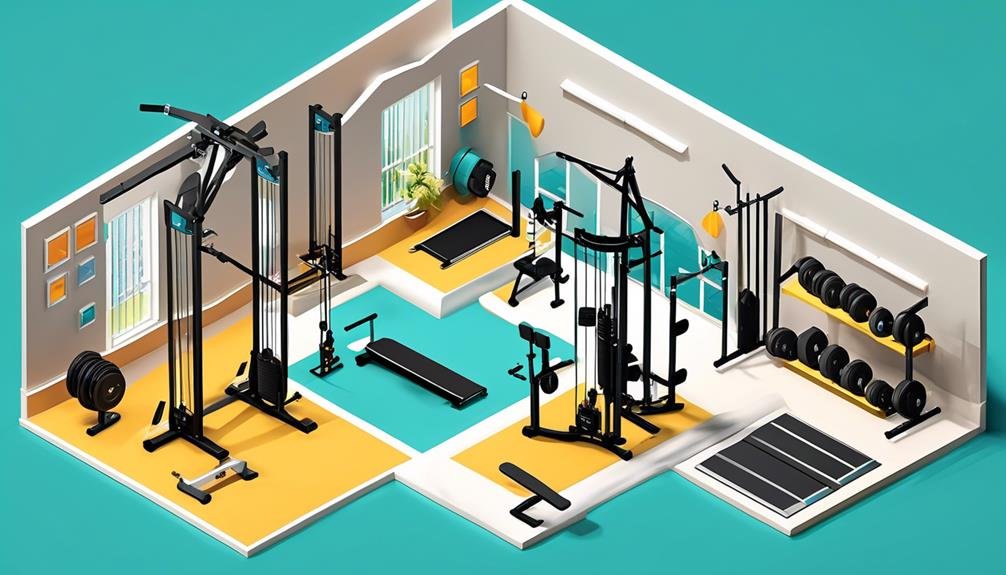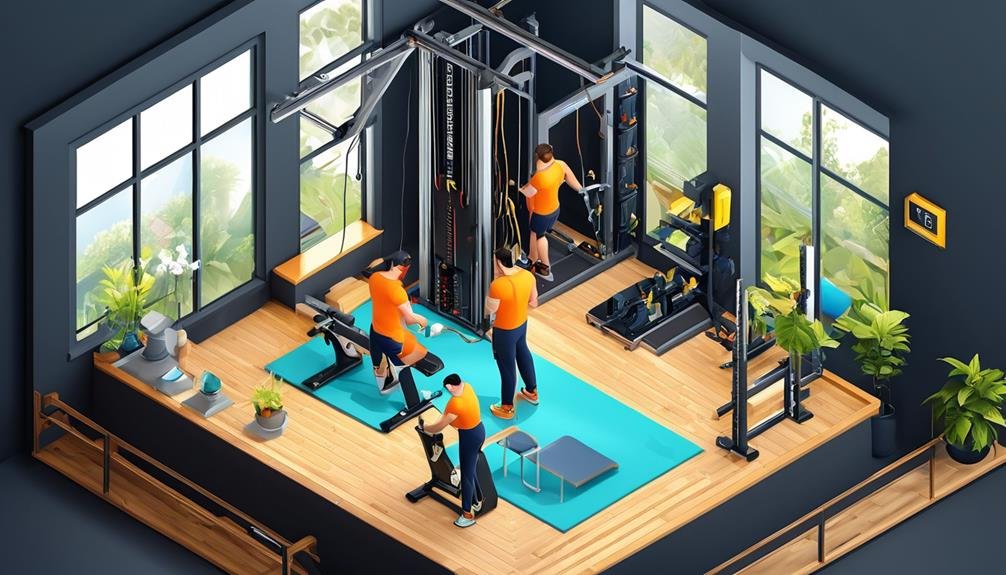Disclaimer: This content is for informational purposes only and does not replace professional medical advice, diagnosis, or treatment. Always consult a qualified healthcare provider before beginning any new exercise program.
They say, 'A journey of a thousand miles begins with a single step.' Similarly, your fitness journey begins with the right personal trainer who can guide you towards your goals.
When it comes to home gym sessions, it's crucial to choose a personal trainer with the appropriate qualifications. But what exactly should those qualifications be?
In this discussion, we will explore the essential qualifications that a personal trainer should possess for home gym sessions. From accredited certifications to specialized knowledge and effective communication skills, we will uncover the key factors that make a personal trainer the perfect fit for your at-home fitness journey.
So, let's dive in and discover what it takes to find the ideal personal trainer for your home gym sessions.
Key Takeaways
- Accredited certification from recognized organizations like ACSM or NASM is essential for personal trainers conducting home gym sessions.
- Personal trainers should have a deep understanding of essential home gym equipment and be adaptable and creative in designing workouts with minimal equipment.
- Familiarity with a wide range of home gym equipment and the ability to adapt exercises and training programs based on available equipment and space constraints is crucial.
- Personal trainers should have experience in creating customized workout plans tailored to clients' individual needs, fitness levels, and goals, and should prioritize safety and injury prevention in their training approach.
Accredited Personal Trainer Certification
To become a qualified personal trainer for home gym sessions, you must obtain an accredited certification from recognized organizations such as the American College of Sports Medicine (ACSM) or the National Academy of Sports Medicine (NASM). These certifications are essential for establishing credibility and ensuring that you have the knowledge and skills necessary to effectively train clients in their own homes.
Becoming a certified personal trainer (CPT) requires passing an examination that tests your understanding of fitness principles, exercise techniques, and client assessment. Additionally, you must hold a current CPR/AED qualification, have a high school diploma or equivalent, and be at least 18 years old.
When selecting a certification program, it's important to choose one that's accredited by the National Commission for Certifying Agencies (NCCA). This accreditation ensures that the certification is recognized and respected within the industry.
In addition to certification, experienced personal trainers should also consider obtaining liability insurance to protect themselves and their clients. This insurance provides coverage in case of accidents or injuries that may occur during personal training sessions.
Specialization in Home Gym Training
A personal trainer specializing in home gym training should possess a recognized certification and substantial experience in the field. They should have a deep understanding of essential home gym equipment such as dumbbells, resistance bands, kettlebells, and stability balls. With this knowledge, they can design effective workouts using minimal equipment.
What sets them apart is their adaptability and creativity. They can adapt exercises and routines to different home environments and limited equipment. They're also resourceful in using household items for workouts.
A specialization in home gym training requires a client-centered approach. These trainers personalize workout plans according to individual fitness goals and needs. They also prioritize customer service and build strong relationships with clients.
It's crucial for the trainer to have liability insurance specific to in-home personal training. This insurance protects against potential lawsuits and ensures client safety during workouts.
Knowledge of Home Gym Equipment
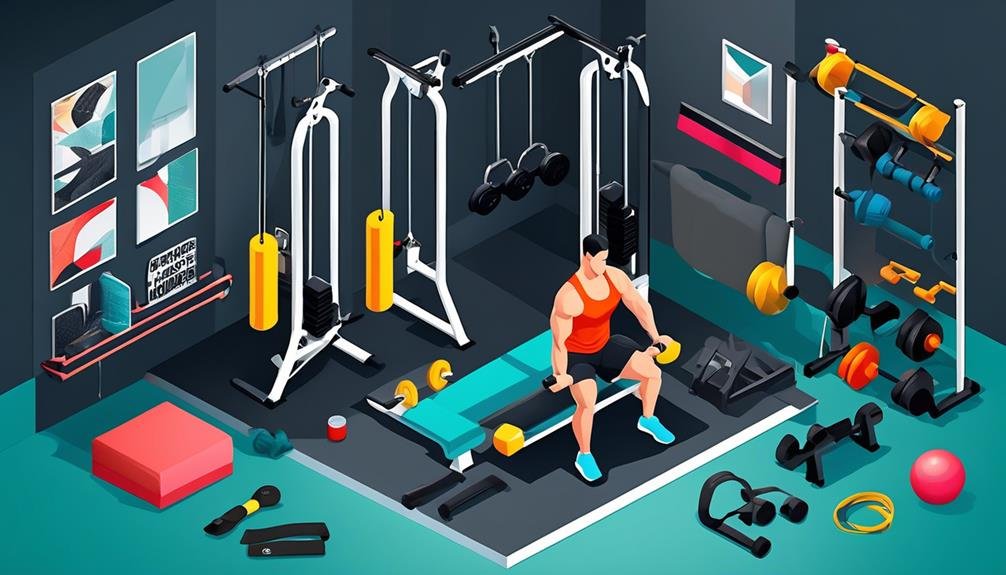
Having a thorough understanding of various home gym equipment is essential for a personal trainer specializing in home gym training. As a personal trainer, your knowledge of gym equipment will greatly impact the effectiveness and safety of your clients' workouts.
Here are three important reasons why having knowledge of home gym equipment is crucial for your qualifications as a personal trainer:
- Familiarity with a wide range of home gym equipment, such as dumbbells, barbells, resistance bands, and stability balls, is essential for effective training sessions. Knowing how to properly use these equipment and incorporate them into different exercises will allow you to create diverse and challenging workouts for your clients.
- Understanding the proper use, safety considerations, and modifications for different home gym equipment is crucial for maximizing the effectiveness of workouts. This knowledge will help you guide your clients on proper form, prevent injuries, and make necessary adjustments based on their fitness levels and goals.
- Knowledge of how to adapt exercises and training programs based on the available home gym equipment and space constraints is important for creating tailored workouts. Being able to work with limited equipment or small spaces will allow you to provide effective training sessions regardless of the resources available to your clients.
Experience in Creating Customized Workout Plans
Experienced personal trainers excel in creating customized workout plans that cater to clients' individual needs, goals, and fitness levels. They possess the qualifications and experience necessary to design tailored exercise routines that yield effective and personalized results. A skilled personal trainer should have a proven track record of developing workout plans for clients with diverse fitness levels and goals. They should be able to assess clients' individual needs, including their fitness level, health conditions, and personal preferences, in order to craft comprehensive and effective workout programs.
To evoke emotion and engage the audience, here is an example of a table that illustrates the impact of personalized workout plans:
| Client A | Client B |
|---|---|
| Goal: Weight loss | Goal: Strength training |
| Fitness Level: Beginner | Fitness Level: Intermediate |
| Health Conditions: None | Health Conditions: Asthma |
| Personal Preferences: Cardiovascular exercises | Personal Preferences: Resistance training |
An experienced personal trainer should also possess the ability to modify and adjust workout plans as needed to accommodate clients' progress, challenges, and changing fitness goals. They should have a deep understanding of various training modalities, exercise techniques, and equipment usage. By demonstrating successful client outcomes and results, personal trainers can showcase the direct impact of their customized workout plans.
Understanding of Safety and Injury Prevention
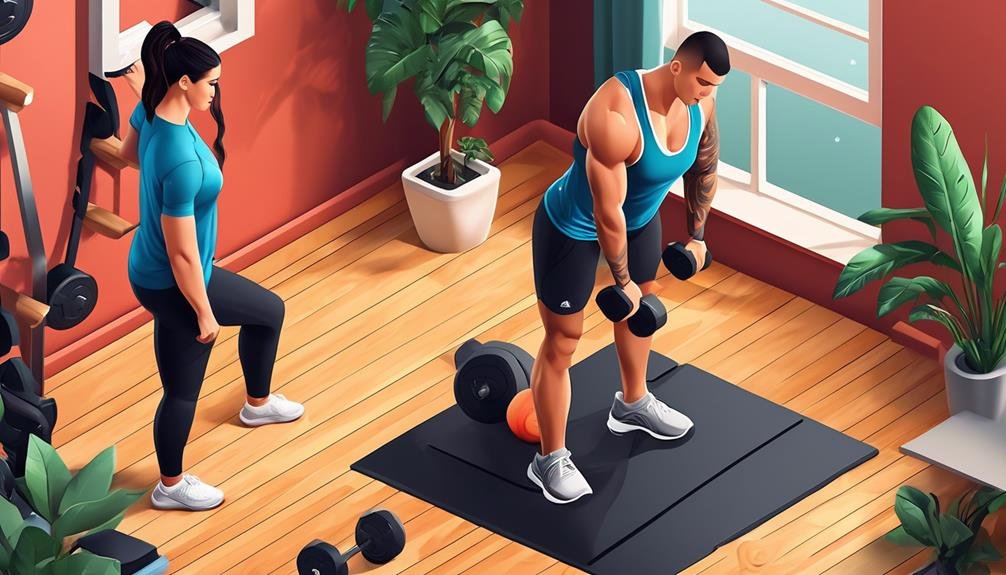
To ensure a safe and injury-free home gym session, a qualified personal trainer must have a comprehensive understanding of safety protocols and injury prevention techniques. Here are three key factors that demonstrate their understanding of safety and injury prevention:
- Knowledge of proper form and technique: A skilled personal trainer knows the correct form and technique for each exercise to minimize the risk of injury. They can teach you how to perform exercises safely and effectively, ensuring that you're using the correct muscles and avoiding unnecessary strain.
- Ability to assess and address potential safety hazards: A competent personal trainer will assess your home gym environment for potential safety hazards. They'll identify any issues, such as faulty equipment or insufficient space, and provide solutions to mitigate risks. This ensures that your training environment is safe and conducive to effective workouts.
- Understanding of client limitations and medical conditions: A knowledgeable personal trainer takes into account your individual limitations and any medical conditions you may have. They'll tailor your workouts accordingly, selecting exercises that are appropriate for your fitness level and ensuring that you don't engage in activities that could aggravate existing injuries or conditions.
Effective Communication and Motivational Skills
Effective communication and motivational skills are essential for a personal trainer to create an engaging and supportive environment for their clients during home gym sessions.
Active listening is a crucial skill that trainers should possess. By attentively listening to their clients, trainers can better understand their needs and concerns, allowing them to tailor their approach accordingly.
Positive reinforcement is another important aspect of effective communication. Trainers should provide uplifting feedback and encouragement to motivate clients and reinforce their progress and efforts.
Empathy is also key in establishing a supportive training environment. By understanding and sharing their clients' feelings, trainers can create a safe space for clients to express themselves and overcome any obstacles they may face.
Goal setting is another vital skill that trainers should possess. By collaborating with clients to establish realistic and achievable fitness goals, trainers provide motivation and direction.
Lastly, adaptability is crucial. Personal trainers should be able to adjust their communication and motivational techniques to cater to individual client personalities, needs, and preferences.
Continuous Professional Development and Education

To continually enhance their skills and expertise, personal trainers prioritize continuous professional development and education. By staying up to date with the latest industry trends, techniques, and best practices, they ensure that they're providing their clients with the most effective and efficient training possible. Here are three ways personal trainers engage in continuous professional development and education:
- Seeking out new courses, workshops, and certifications: Personal trainers are always on the lookout for opportunities to expand their knowledge and skills. They actively seek out courses, workshops, and certifications that will help them stay current in the industry and provide their clients with the best possible training.
- Regular reading and research: Personal trainers understand the importance of staying informed. They dedicate time to reading books, articles, and research papers to stay up to date with the latest developments in exercise science, nutrition, and other relevant fields.
- Attending conferences, seminars, and webinars: Personal trainers recognize the value of networking and learning from their peers. They attend industry conferences, seminars, and webinars to gain new insights, exchange knowledge, and expand their professional network.
Frequently Asked Questions
Can You Personal Train at a Home Gym?
Yes, you can personal train at a home gym. However, it's important for a personal trainer to have the necessary qualifications, such as certifications from reputable organizations and a background in exercise physiology or sports medicine.
What Qualifications Should a Personal Trainer Have?
A personal trainer should have a degree in exercise or a related field, along with certifications from recognized organizations like ACSM or ACE. These qualifications ensure they have the knowledge and expertise to guide you effectively in your home gym sessions.
What Certification Do Most Personal Trainers Have?
Most personal trainers have certifications from recognized organizations like ACSM, ACE, NSCA, NASM, or AFAA. These certifications require specific qualifications and are a minimum requirement for trainers.
What Is the Difference Between a Gym Trainer and a Personal Trainer?
A gym trainer typically works in a gym setting, while a personal trainer provides individualized sessions. Personal trainers tailor exercises to your needs, offer guidance on nutrition, and focus on helping you achieve your specific fitness goals.
Conclusion
In conclusion, when seeking a personal trainer for home gym sessions, it's crucial to consider their qualifications. Look for trainers with accredited certifications from reputable organizations and a specialization in home gym training. They should have extensive knowledge of home gym equipment and be able to create customized workout plans.
Safety, injury prevention, effective communication, and motivational skills are also important factors to consider. A personal trainer should prioritize the safety of their clients and have the knowledge and expertise to prevent injuries. Effective communication is crucial for understanding clients' goals and needs, as well as providing clear instructions during workouts. Additionally, a personal trainer should possess strong motivational skills to keep clients engaged and motivated throughout their fitness journey.
Lastly, a commitment to continuous professional development and education ensures that they stay up-to-date with the latest fitness trends and techniques. A personal trainer who actively seeks opportunities to expand their knowledge and skills is more likely to provide a high-quality and effective training experience for their clients.
Overall, choosing a personal trainer for home gym sessions requires careful consideration of their qualifications, including certifications, specialization, knowledge of equipment, and ability to create customized workout plans. Safety, effective communication, and motivational skills are also crucial factors to consider. Lastly, a commitment to continuous professional development and education ensures that the personal trainer stays current with the ever-evolving fitness industry.
